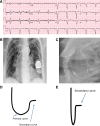Right Ventricular Septal Pacing: A Paradigm Shift
- PMID: 32494491
- PMCID: PMC7252807
- DOI: 10.19102/icrm.2018.090501
Right Ventricular Septal Pacing: A Paradigm Shift
Abstract
The right ventricular (RV) apex has been considered to be the primary site for ventricular lead implantation since the original descriptions of permanent pacing. However, long-term RV apical pacing has been shown to have negative effects on ventricular function and hemodynamics as a result of ventricular dyssynchrony. Alternative sites of ventricular pacing, particularly the RV septum and His bundle, have been evaluated for patients with a need for long-term ventricular pacing. In this article, we review the available data on the use of these alternative sites for RV pacing.
Keywords: His-bundle pacing; right ventricular apical pacing; right ventricular septal pacing.
Copyright: © 2018 Innovations in Cardiac Rhythm Management.
Conflict of interest statement
Dr. Vijayaraman reports that he is a speaker and consultant for Medtronic and on the advisory board for Boston Scientific. Dr. Sharma reports that he is a speaker and consultant for Medtronic and a consultant for St. Jude Medical, now Abbott Laboratories. Ms. Worsnick reports no conflicts of interest for the published content.
Figures




References
-
- Tracy CM, Epstein AE, Darbar D, et al. 2012 ACCF/AHA/HRS focused update of the 2008 guidelines for device-based therapy of cardiac rhythm abnormalities: a report of the American College of Cardiology Foundation/American Heart Association Task Force on Practice Guidelines. J Am Coll Cardiol. 2012;60(14):1297–1313. [CrossRef] [PubMed] - DOI - PubMed
-
- Zou C, Song J, Li H, et al. Right ventricular outflow tract septal pacing is superior to right ventricular apical pacing. J Am Heart Assoc. 2015;4(4):pii:e001777. [CrossRef] [PubMed] - DOI - PMC - PubMed
-
- Chen K, Mao Y, Liu SH, et al. Is right ventricular midseptal pacing superior to apical pacing in patients with high degree atrio-ventricular block and moderately depressed left ventricular function? J Zhejiang Univ Sci B. 2014;15(6):507–514. [CrossRef] [PubMed] - DOI - PMC - PubMed
-
- Tops LF, Schalij MJ, Bax JJ. The effects of right ventricular apical pacing on ventricular function and dyssynchrony: implications for therapy. J Am Coll Cardiol. 2009;54(9):764–776. [CrossRef] [PubMed] - DOI - PubMed
-
- Lamas GA, Lee KL, Sweeney MO, et al. Ventricular pacing or dual-chamber pacing for sinus-node dysfunction. N Engl J Med. 2002;346(24):1854–1862. [CrossRef] [PubMed] - DOI - PubMed
Publication types
LinkOut - more resources
Full Text Sources
Miscellaneous
